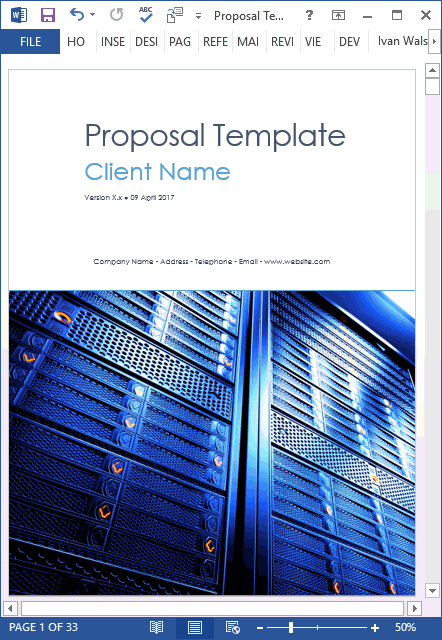Proposal Writing
Proposal Writing Course – Lesson #2: Are you Proposing a Solution or a Product?
Successful proposals place the emphasis on the client’s needs rather than on your abilities, technology, or experience, regardless of their technical merit.
[ Learn more about these Proposal Templates ]
Novice proposal writers tend to hype their own products/services and relegate the client’s needs to second place
For example, a proposal for a Content Management system would list must-have technology features and new bleeding-edge technology.
A more seasoned writer would discuss *why* the agency needs a Content Management system in the first place, and then articulate the business benefits that their proposed system would offer.
In other words, the second approach discusses a solution to a problem—rather than a wonderful new product. Government agencies buy solutions not products.
To keep our proposal client-centric, we need to consider the following:
1. What are the proposal’s main weaknesses?
This can be a very tricky area, as the sheer audacity to suggest that the proposal has weaknesses will often be dismissed with derision by the grievously offended bid team.
Nonetheless, if you are the Bid Manager, it is your responsibility to raise this issue. Otherwise, you are working with your ‘head in the sand’ oblivious to the bid’s shortcomings. Refinement is what you are after here. By examining the proposal with an impartial eye, you can see its weakness and then work to resolve these.
For example:
- What is your unique selling point or key differentiator?
- What is the weakest section in the bid?
- On what grounds could it be rejected?
- Have you explained the benefits clearly?
- Would you buy it?
Actually, the last one is the most critical. Ask your bid team this question. If they hem and haw, it might be time to get an external opinion.
These are some of the most critical issues when submitting a proposal.
Other things for consideration include:
- Any assumptions you make need clear explanations.
- Any recommended course of action (and the consequences of inaction) needs to be discussed.
- Human resource issues such as mobilizing staff, scheduling, and contingency plans.
2. How to demonstrate improvements to productivity and profitability?
Every bid boasts of value-for-money. The proposal evaluator’s eyes glaze over when they read this—as would yours, no doubt.
Instead, of hyping your proposal, demonstrate your ability to:
- Show how you can improve productivity.
- Discuss other projects where you have achieved this.
- Outline the potential costs savings.
In many respects, there will be some guesswork here, but at least it shows that you are making a serious effort to understand their business needs. Most of your competitors will not be so industrious.
3. How to build trust with the client?
Building trust takes time in most everyday situations. In the contracting world, government agencies are often under intense pressure to award contracts very swiftly in order to accelerate large-scale projects.
Regardless of the quality of your bid, trust and reliability will always be an issue; the awarding agency needs to trust the bidder. After all, if they hand you the contract and you under-perform (i.e. screw-up badly), it will reflect very poorly on them.
However, during the tendering process you will get several opportunities to build bridges with the government team. Examples of these include:
Clarifications — always send in clarifications as this demonstrates that you are examining the finer details and have examined the proposals in detail. When preparing Request for Proposal, RFIs and EOIs mistakes can creep in; if you find these, ask for clarification.
In addition, if your own team does not raise any clarification questions—and your competitors do—you may need to consider your team’s commitment to the bid.
Presentations — if you succeed in getting shortlisted, use the session to *listen* to what they are saying. Ask open-ended questions.
Take notes. Use the meeting to illustrate that you are presenting to them—not just walking through another PowerPoint presentation. They have seen endless presentations and most all look the same. Again, ask open-ended questions and take notes.
4. What key recommendations have you made?
Most proposals include a set of recommendations. These serve as the foundation of your solution and emphasize the key criteria for consideration. Support your recommendations with references, endorsements, statistics, benchmarks—whatever gives your recommendations more substance.
If you cannot support your recommendations, your words will be dismissed as mere sales hype.
And, have you suggested (however subtly) what could happen if they do not take your recommendations on board?
Remember FUD – Fear, Uncertainty, and Doubt. Most experienced sales writers will weave one of these three into their sales proposal; it is an indirect call-to-action as it implies that if you do not take some action there could be negative repercussions.
5. Getting the right balance between topics and sections
Open-ended proposals allow the bidder to submit as much content as they wish. Other proposals will specifically request that you stay under x number of pages.
In either case, when reviewing the first major draft, you need to consider:
- Inclusiveness — Revise all major sections to ensure that you have included the major themes, selling points, and recommendations around which your proposal is structured.
- Focus — Note the weaker sections and re-write them with more focus. You don’t need to edit (i.e. reduce the word count) of the entire document, but any sections that appears to be ambiguous, vague or rambling need refinement.
- Expansions — sections that appear to be incomplete, underwritten, or lack persuasiveness need further expansion. Using tables and graphs is a nice way to counterbalance pages of text.
6. Use Plain Language
Many proposal writers use a dense, convoluted style of writing in the assumption that it will impress the evaluators. Proposals choked with multiple adjectives, lengthy sub-clauses and hundred-word paragraphs make life very hard for the evaluators.
Remember, on large projects, the evaluators will read several thousands of pages when reviewing the bids. It is in your interest to write in clear, concise prose which can be easily understood.
In IT proposals, writers often indiscriminately throw in new terms, acronyms and expressions. For example, I read a proposal recently that referred to a ‘corporate dash-board.’ Even the proposal writers did not know what it meant; but they thought it sounded good!
With that said, you have to explain the business/software terminology in language appropriate for the reader. Remove all cryptic IT references, sales waffle, and unexplained TLA’s (three-name-acronyms, such as B2B).
7. Your Bid versus the Competition
Most government contractors know the competition before they even bid. For example, in Ireland, under the Freedom of Information Act, you can request the names of those who bid for a previous project; the size of the contract award is also published.
Before bidding, you should identify your single most likely competitor. If you don’t know this, it will make certain parts of your bid very hard to complete, such as the costs, daily rates and discounts.
There are a few ground rules here. In your bid, never directly insult your competitors by name. This will make you look petty and will lower the tone of your bid. It is a cheap shot and will always backfire.
Instead, explore how you can positively pitch your proposal against the competition.
Once you have worked out your respective strengths, weave them into the response where they are most appropriate, such as in the Executive Summary and the Understanding of Requirements.
By taking these points into consideration, you will begin to shift from writing ‘product orientated proposals’ and start delivering proposals that put the customer right at the heart of your response.
The first few attempts to make this shift will require a slight learning curve, but once your mastered it, your target customers will start responding in a much more positive light.
Tell us what you think about writing proposals. Have we missed something obvious? What’s the best tip you can give to someone writing a client-centric proposal for the first time?
[ Learn more about these Proposal Templates ]



